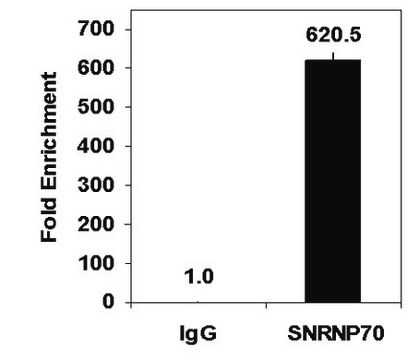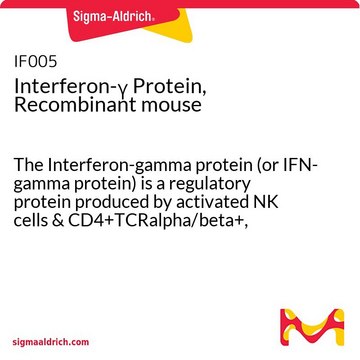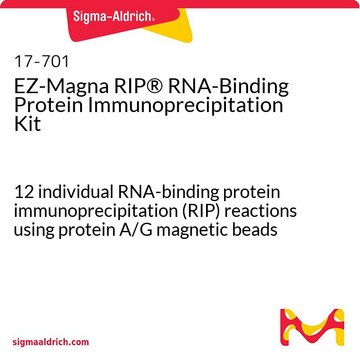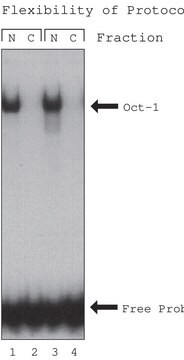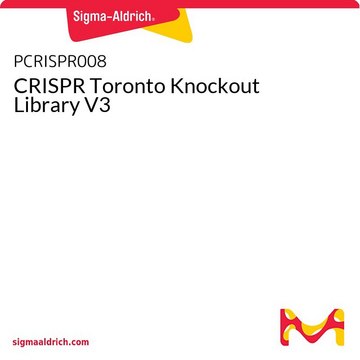407303
γ-Interferon, Mouse, Recombinant, E. coli
Synonym(s):
IFNG, Type II IFN
Sign Into View Organizational & Contract Pricing
All Photos(1)
About This Item
UNSPSC Code:
12352202
NACRES:
NA.77
Recommended Products
Assay
≥95% (SDS-PAGE)
Quality Level
form
liquid
manufacturer/tradename
Calbiochem®
storage condition
OK to freeze
avoid repeated freeze/thaw cycles
solubility
water: soluble
Protein ID accession no.
UniProt accession no.
shipped in
wet ice
storage temp.
−70°C
Gene Information
mouse ... Ifng(15978)
General description
Note: 1 KU = 1000 units.
Research area: Immunology and Cytokines
Recombinant, mouse γ-interferon, consisting of 134 amino acids, expressed in E. coli as a single, non-glycosylated polypeptide.
Recombinant, mouse γ-interferon, consisting of 134 amino acids, expressed in E. coli as a single, non-glycosylated polypeptide.
Application
γ-Interferon has been used to assess the response of wild-type and cytosolic phospholipase A2 (cPLA2)-deficient cells to IFN-mediated signals. It has also been used to study the signaling pathway associated with IFN-γ and to explore the potential role of β-Arrestin1 in the dephosphorylation of signal transducer and activator of transcription 1 (STAT1).
Biochem/physiol Actions
Interferon-gamma (IFN-γ), a proinflammatory cytokine, exhibits a significant impact on innate and adaptive immunity in terms of combatting intracellular infections and facilitating tumor control. It has a significant impact on various immunological pathways. IFN-γ influences the following biological processes:
Antigen Processing and Presentation: IFN-γ enhances the expression of molecules involved in antigen presentation. This helps in the efficient activation of T cells, leading to the initiation of adaptive immunity.
Reactive Oxygen Species (ROS): IFN-γ stimulates the production of ROS by promoting the assembly of NADPH oxidase subunits. These ROS possess strong microbicidal effects, aiding in the defense against invading pathogens.
Autophagy: IFN-γ induces the expression of proteins involved in autophagy, facilitating the clearance of intracellular pathogens and contributing to immune defense.
Apoptosis: IFN-γ triggers apoptotic cell death by increasing the expression of molecules associated with the apoptotic pathway.
Cell Migration and Leukocyte Traffic: IFN-γ promotes the expression of chemokines and adhesion molecules, facilitating immune cell migration and contributing to the initiation of inflammatory responses.
Antiviral Mediators: By inducing the expression of various antiviral proteins, IFN-γ counteracts viral infections at multiple stages of the viral life cycle.
Antigen Processing and Presentation: IFN-γ enhances the expression of molecules involved in antigen presentation. This helps in the efficient activation of T cells, leading to the initiation of adaptive immunity.
Reactive Oxygen Species (ROS): IFN-γ stimulates the production of ROS by promoting the assembly of NADPH oxidase subunits. These ROS possess strong microbicidal effects, aiding in the defense against invading pathogens.
Autophagy: IFN-γ induces the expression of proteins involved in autophagy, facilitating the clearance of intracellular pathogens and contributing to immune defense.
Apoptosis: IFN-γ triggers apoptotic cell death by increasing the expression of molecules associated with the apoptotic pathway.
Cell Migration and Leukocyte Traffic: IFN-γ promotes the expression of chemokines and adhesion molecules, facilitating immune cell migration and contributing to the initiation of inflammatory responses.
Antiviral Mediators: By inducing the expression of various antiviral proteins, IFN-γ counteracts viral infections at multiple stages of the viral life cycle.
Warning
Toxicity: Standard Handling (A)
Physical form
In 10 mM PBS, pH 7.4.
Preparation Note
Dilute only in buffers containing protein such as 0.1% BSA.
Reconstitution
Following initial thaw, aliquot and freeze (-70°C).
Other Notes
Zantl, N., et al. 1998. Infect. Immun. 66, 2300.
Familletti, P.C., et al. 1981. Methods Enzymol. 78, 387.
Familletti, P.C., et al. 1981. Methods Enzymol. 78, 387.
Legal Information
CALBIOCHEM is a registered trademark of Merck KGaA, Darmstadt, Germany
Storage Class Code
12 - Non Combustible Liquids
WGK
WGK 2
Flash Point(F)
Not applicable
Flash Point(C)
Not applicable
Certificates of Analysis (COA)
Search for Certificates of Analysis (COA) by entering the products Lot/Batch Number. Lot and Batch Numbers can be found on a product’s label following the words ‘Lot’ or ‘Batch’.
Already Own This Product?
Find documentation for the products that you have recently purchased in the Document Library.
Christin Pelzel et al.
Molecular cell, 50(1), 149-156 (2013-04-16)
Signal transducer and activator of transcription 1 (STAT1) is activated by tyrosine phosphorylation upon interferon-γ (IFNγ) stimulation, which results in the expression of genes with antiproliferative and immunomodulatory functions. The inactivation of STAT1 occurs through tyrosine dephosphorylation by the tyrosine
Our team of scientists has experience in all areas of research including Life Science, Material Science, Chemical Synthesis, Chromatography, Analytical and many others.
Contact Technical Service

